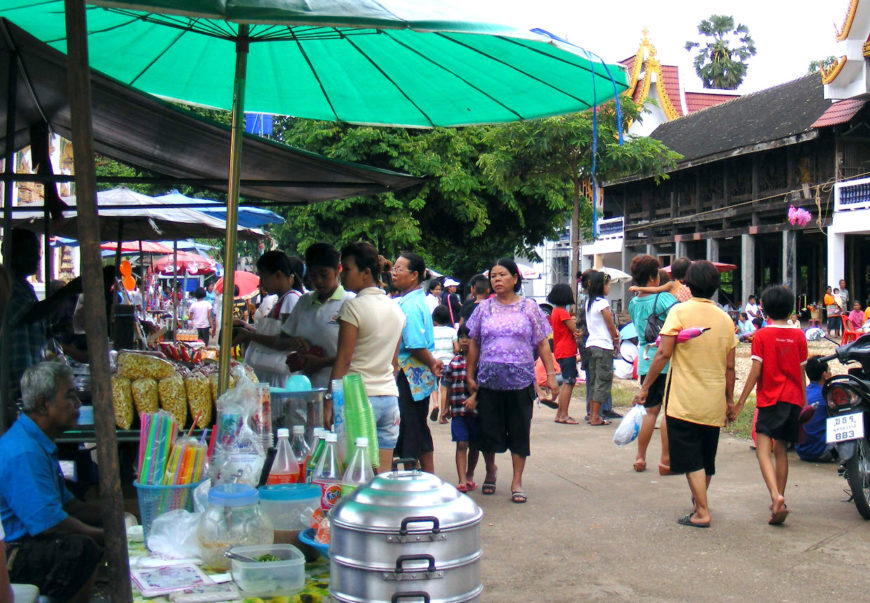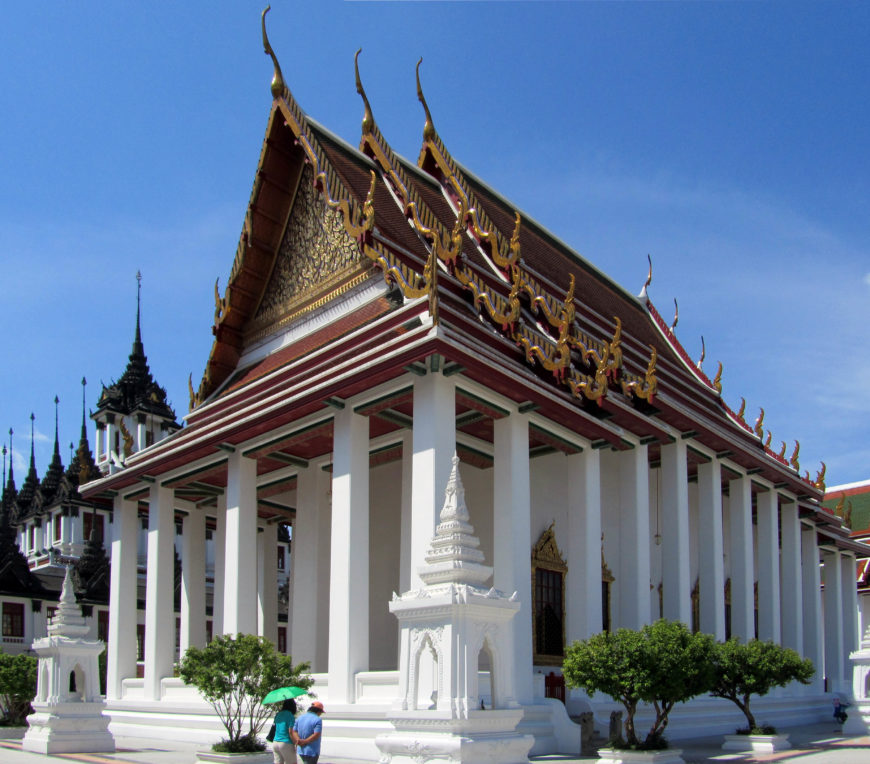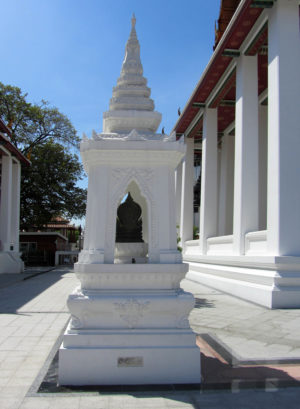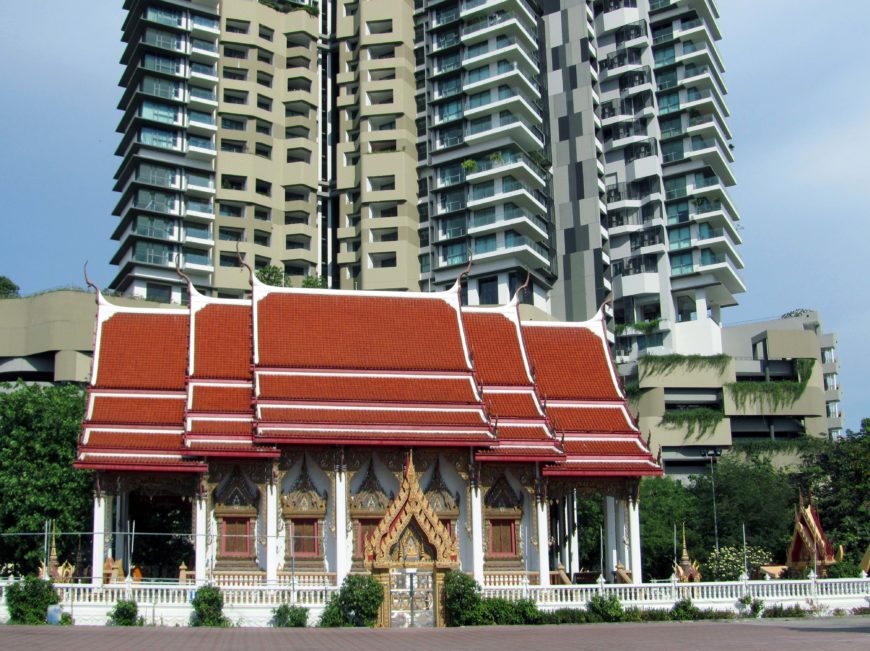
Wat Dan, a Buddhist monastery adjacent to a high-rise condominium complex in Bangkok, Thailand (photo: Jessica Patterson, CC BY-NC-SA)
The tranquil drone of chanting monks drifts from the dimly lit interior of an elaborately ornamented building housing a large golden statue of the Buddha. The temple is nestled in an oasis of green grass bordering clean-swept paths, groves of trees where birds sing, and ponds full of fish and turtles. Surrounded by natural beauty and the ritualized patterns of monastic life, time seems to move at a slower pace. But only steps away, outside the temple gate, cars honk and fume on crowded streets, and the secular world is in full swing of business and hustle. In Thai cities, Buddhist temples occupy the urban landscape like lotuses blooming from a muddy pond, a potent symbol of spirituality amid mundane life.
Wat (Monastery), วัด
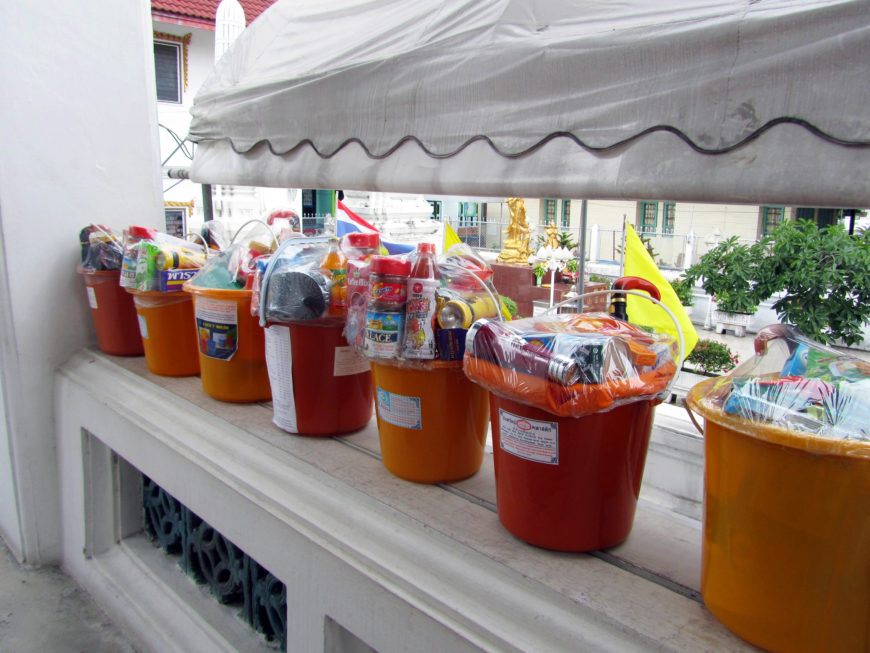
Gift buckets on a ledge at Wat Mahanpharam, Bangkok, containing a variety of useful items donated to the monks by layfolk. Visible are various food products, sandals, flashlights, and umbrellas (photo: Jessica Patterson, CC BY-NC-SA)
In the Western imagination, Buddhist monasteries are often envisioned as isolated and remote. While this is accurate for the many mountaintop monasteries of East Asia, the Buddhist monasteries of Thailand are usually located within or in close proximity to villages, towns, and cities. Thai Buddhist monasteries are not self-supporting, but exist in a symbiotic relationship with the lay community. Monks support the spiritual needs of the lay community, who in turn support the material needs of the monks. Donations and activities that support the sangha and the monasteries in which they reside are among the most potent forms of merit-making available to lay Buddhists. In many parts of Thailand, monks still perform the ancient practice of walking in procession on a morning alms round. [1] In dense urban areas where the alms round is not possible, or on other ceremonial occasions, the lay community will bring food and other necessaries to the monastery. Because of this mutual dependence, a monastery only thrives to the extent that the lay community is motivated to support it.
A Thai Buddhist monastery combines elements of the solemn and the sanuk, allowing it to serve a wide range of spiritual, aesthetic, and social needs. While the monks are expected to comport themselves in public with an air of solemn gravity, members of the lay community are welcome to visit monasteries as much for pleasure as piety, making small donations here and there as they attend ceremonies, pay respects at various altars and shrines, use divining sticks to tell their fortunes, or simply admire the beauty of the grounds and architecture. Some monasteries host periodic temple fairs, during which the grounds are temporarily transformed by a variety of playful diversions, such as vendor stalls, games, and food carts.
The total complex of a Thai Buddhist monastery is called a wat. The term wat is also the first element in the name of each site. The formal name of the wat tends to be a long construction derived from Pali and poetic language. The full-length of the monastery is rarely used outside of the most formal contexts, and an even briefer nickname might be common in everyday speech. For example, Wat Phra Chetuphon bears the full formal name “Wat Phra Chetuphon Wimon Mangkhalaram Rachaworamahawihan,” which roughly translates to “The Holy Jetavana Monastery, Unsullied and Auspicious Garden, Royally Bestowed Great Vihara,” but is colloquially referred to as “Wat Pho,” or “Bodhi Tree Monastery.”
Like a college campus, a wat includes a variety of built structures that each serve a specialized function. Some are essential to the operation of a monastery and will be found at every site; others are optional and may or may not be present. The following is not an exhaustive list, but limited to commonly encountered structures with the most art historical interest.
Ubosot (Ordination Hall), อุโบสถ
The ordination hall, or ubosot, is the most sacred and essential building of a wat. Until the ordination hall is completed and consecrated, the monastery cannot function. At many sites, the ordination and assembly halls are similar in design and decoration, but the ordination hall can be identified by the ring of boundary markers that encircle it and denote the borders of the consecrated space (described in more detail below).
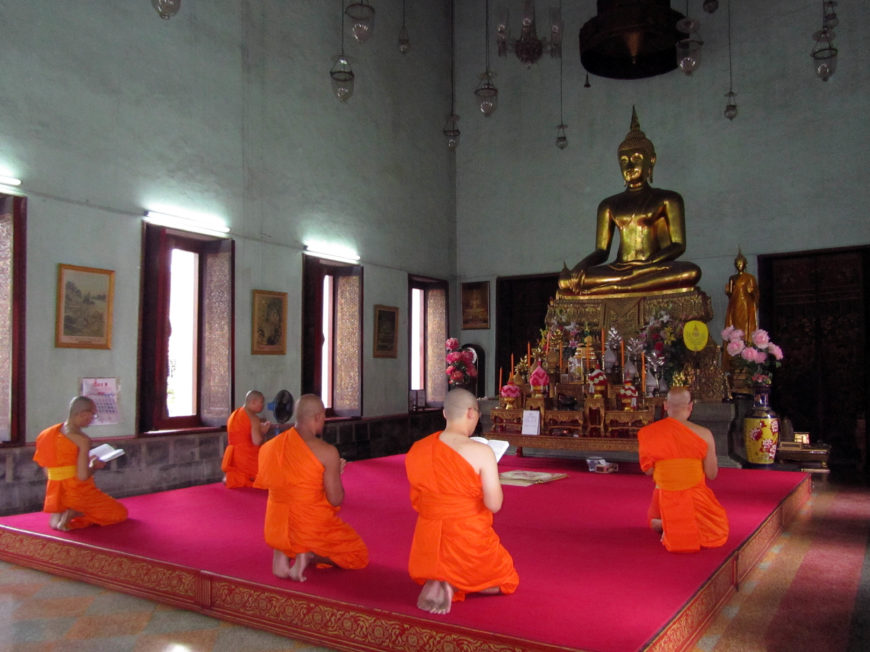
Monks chanting on an elevated dais in the ubosot of Wat Mahanpharam, Bangkok (photo: Jessica Patterson, CC BY-NC-SA)
The form of Buddhism dominant in Thailand derives from a Sri Lankan lineage of Theravada Buddhism, which relies on the older Pali canon of Buddhist scriptures. [2] Twice a day, in the morning and late afternoon, monks assemble in the ubosot to chant passages from the Pali texts. The ubosot is also, as its English name implies, the site where novices are ordained as monks. Inside the ubosot, there is usually a section of floor that is elevated or in some other way demarcated as the area where the monks will sit during ceremonies or while chanting. When layfolk are present at ceremonies, such as ordinations, they occupy the areas outside the monks’ seating zone. Women are not allowed to enter the monks’ area, even when no monks are present. In some very conservative places, women are not permitted in the ubosot at all. [3]
Ordination halls are usually simple in plan, consisting of a one-story rectangular space, but as richly ornamented as funding will allow. The exteriors might be augmented with carved wood, sculpted stucco, or glass mosaic. Mural paintings are commonly found on the door and window panels and the interior walls. Inside the ubosot is a high altar, facing east, containing the main Buddha icon and usually a variety of other images, as well as offerings such as flower arrangements, candles, and decorative objects.
Bai Sema (Boundary Markers), ใบเสมา
The ubosot can be easily distinguished from other buildings at a wat because it is surrounded by bai sema, or boundary markers. These markers may be fashioned in a variety of shapes, sizes, and materials, but usually they are stylized leaf-shaped stones, often raised on plinths or sheltered in open-sided spired structures. Eight boundary markers are evenly spaced around the ubosot in the cardinal and ordinal directions. Bai sema are erected to mark the locations where consecrated stone spheres called luk nimit (ลูกนิมิตร) have been buried underground to demarcate the consecrated area.
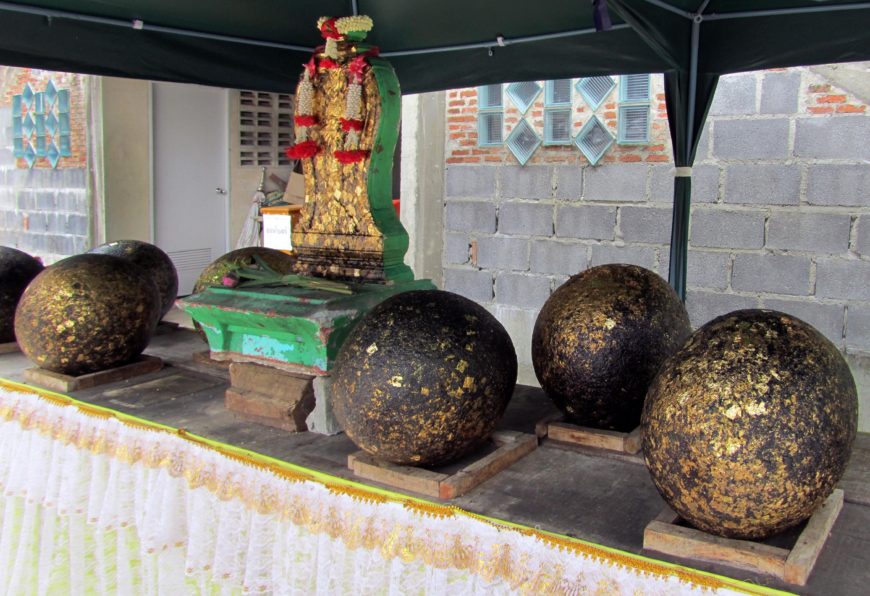
Luk nimit on display at Wat Kaew Fa Chulamanee, Bangkok, next to a bai sema stone, during the renovation and reconsecration of the ordination hall. Temple visitors paying respect to the stones have pressed gold leaf onto their surfaces as a devotional act (photo: Jessica Patterson, CC BY-NC-SA)
In addition to the eight spheres located under the boundary markers that surround the building, an unmarked ninth sphere is buried in the center, directly under the ubosot or its main altar. The luk nimit usually remain buried and unseen, but sometimes when the ordination hall is being renovated and reconsecrated, these stone spheres are unearthed and ceremonially displayed.
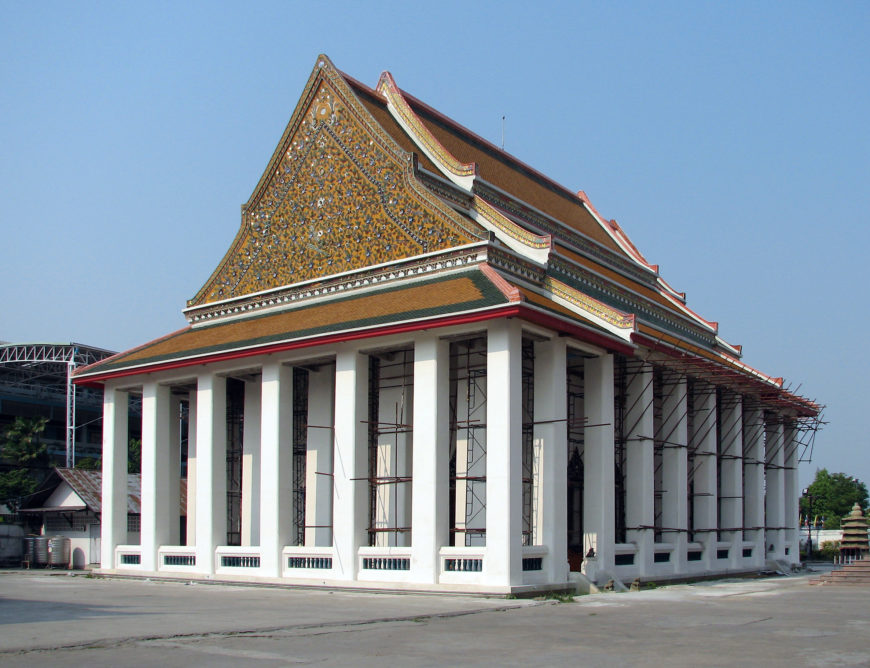
This is the original wihan at Wat Kanlayanamit, Bangkok. It is architecturally very similar to the ubosot, but can be distinguished by the absence of any bai sema stones around its perimeter. A second, larger wihan was subsequently built between the original wihan and ubosot (photo: Jessica Patterson, CC BY-NC-SA)
Wihan (Assembly Hall), วิหาร
Although a wat can have only one ordination hall, the wihan, or assembly halls, are variable in number. A commonly encountered layout for monasteries in central Thailand is one ordination hall and one assembly hall of similar size and appearance standing side-by-side, but there are many other possible arrangements and regional variations. In wealthy or royally sponsored monasteries, the main wihan might be ornamented as lavishly as the ubosot. The interior of a wihan usually has a large altar supporting one or more icons, facing an open floor plan where people can gather and sit. Occasionally there are scheduled events in the assembly halls, such as sermons, but people are also free to visit whenever they like, by themselves or with their families, to pay respects to the Buddha image.
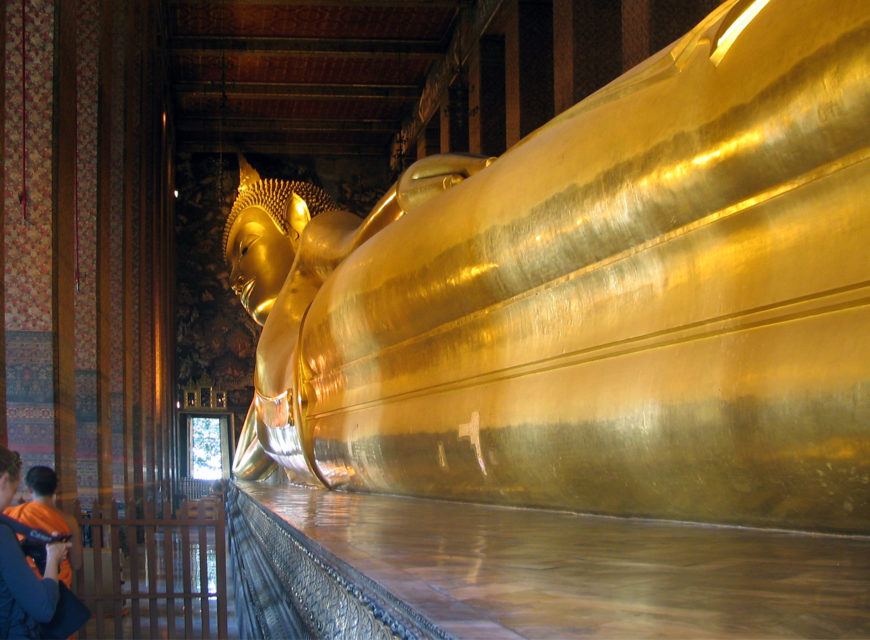
Wihan of the “Reclining Buddha,” Wat Phra Chetuphon, Bangkok, Thailand (photo: Douglas J. McLaughlin, CC BY 2.5)
One notable and well-known exception to this typical plan is the wihan of the “Reclining Buddha” at Wat Phra Chetuphon in Bangkok, where the building is just large enough to accommodate aisles that allow one to walk around the massive icon.
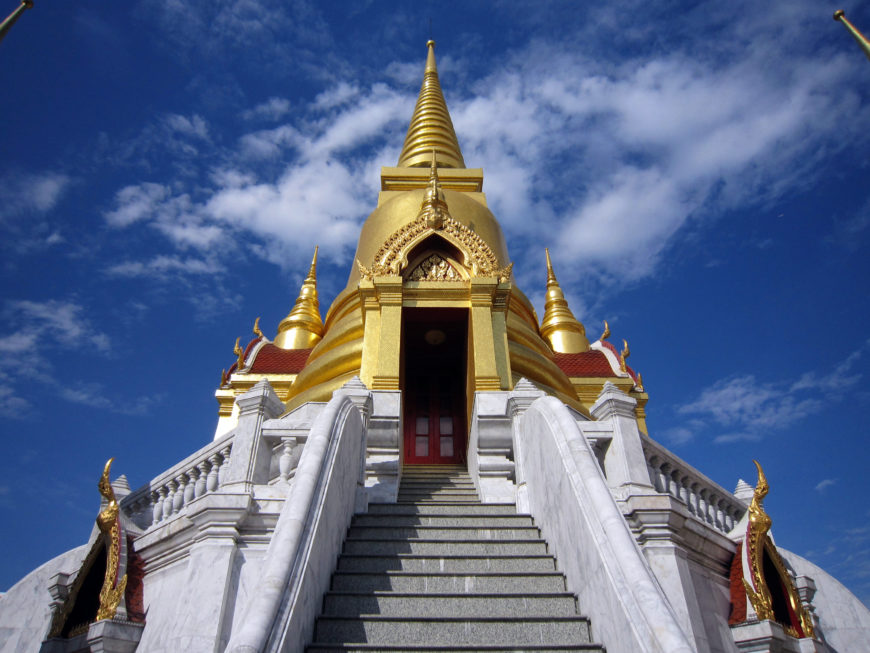
An elaborately constructed chedi with multiple gilded spires at Wat Tri Thotsathep, Bangkok (photo: Jessica Patterson, CC BY-NC-SA)
Chedi (stupa), เจดีย์
Chedi, derived from the Pali cetiya (relic), is the term for a Thai-style stupa, its typical bell-shaped form derived from Sri Lankan architecture. A wat should contain one or more chedi, though they can be highly variable in size. The defining element of a chedi is not only its form, but its function as a reliquary. However, the relics it encloses can be of any type: sariraka (bodily relics), paribhogaka (relics of association), or uddesika (relics of reminder). [4] Some monasteries set aside space for funeral monuments in the shape of small chedi that enclose ashes of the cremated deceased.
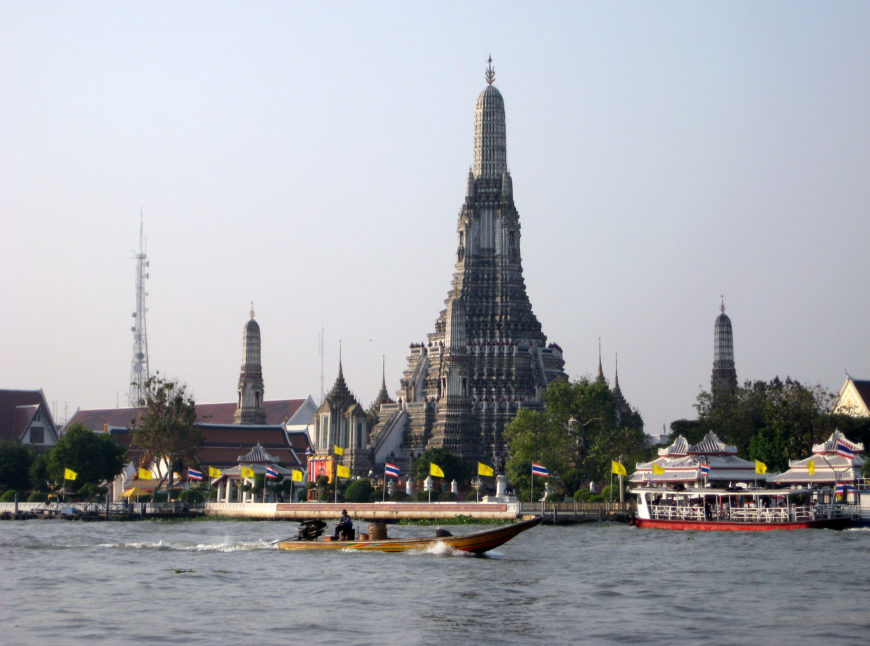
The most famous prang in Thailand is the one at Wat Arun, Bangkok. Seen to best advantage from the river, it consists of five prang spires in a quincunx pattern reminiscent of the central structure at Angkor Wat (photo: Jessica Patterson, CC BY-NC-SA)
Prang (Khmer-type spire), ปรางค์
Prang, a type of spire derived from Khmer architecture, are usually encountered in royally sponsored Thai monasteries with royal patronage. Descended from the robustly proportioned stone prang that surmount the medieval architecture of Angkor and were closely replicated in Ayutthaya, modern Thai prang are more slender and tapering in form, surmounted with a ridged columnar spire sometimes likened to a corncob. The empire of Angkor once encompassed much of the territory in eastern Thailand; in the mid-nineteenth century, before Western colonial powers imposed borders favoring French interests, Angkor Wat was under the suzerainty of Siam. The prang therefore symbolizes imperial glories of bygone days. The earliest prang housed small internal cells, but modern versions usually lack interior space and more closely resemble stupas. For a given prang to function as a stupa depends on whether it enshrines relics and invites circumambulation; if not, it remains a decorative and symbolic form. [5]
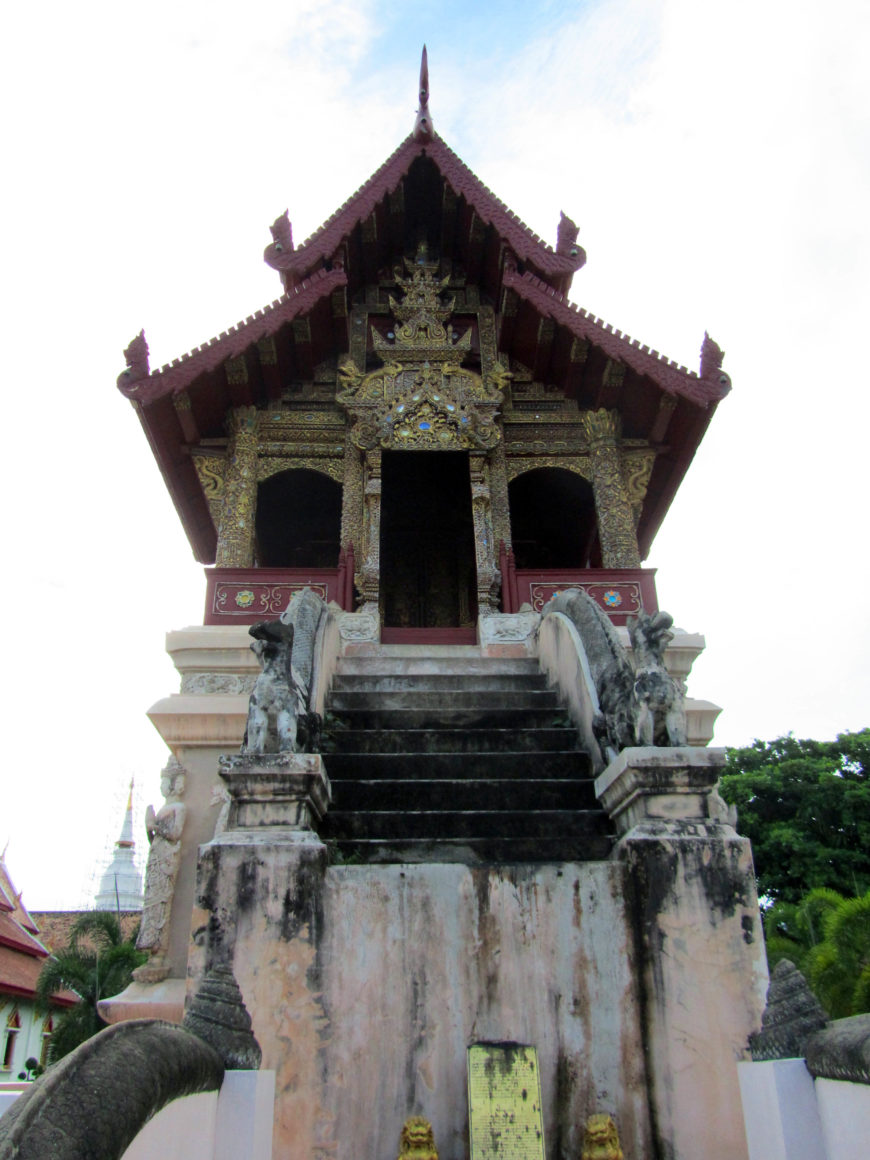
Ho Trai at Wat Phra Singh, Chiang Mai. The small, elaborately adorned wooden building is highly elevated on a masonry base (photo: Jessica Patterson, CC BY-NC-SA)
Ho Trai (Library), หอไตร
Older monasteries sometimes preserve a special structure designed to house Buddhist scriptures, called ho trai. “Ho” means “hall,” and “trai” is the first syllable of Traipithak, the Thai pronunciation of Tripitaka, the “Three Baskets” of canonical Theravada Buddhist texts. The measures taken to protect and honor the sacred texts led to architecturally distinctive features. Traditional ho trai are elevated on a high base and surrounded by water, mitigating the dangers posed by fire and termites.
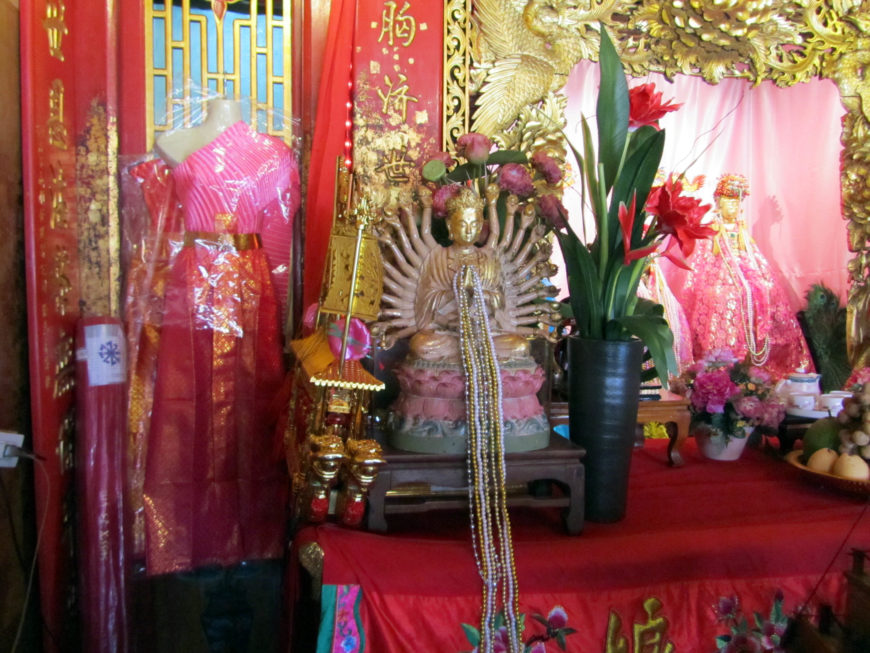
A corner of the shrine to Chao Mae Soi Dokmak at Wat Phanan Choeng, Ayutthaya. The figure of the princess is in the framed niche to the right. The statue of thousand-armed Guanyin in the foreground bears pearl necklaces that, together with pretty fabric and fancy outfits, are popular offerings to the spirit (photo: Jessica Patterson, CC BY-NC-SA)
Assorted minor shrines
In contrast to Mahayana Buddhism, which honors a wide range of Buddhas from distant regions of the cosmos, the Theravada school dominant in Thailand directs devotion primarily to Shakyamuni, the historical Buddha, who lived in our world in the first millennium B.C.E. However, Thai Buddhism is very flexible and inclusive, and a wat may include minor shrines established to honor a broad and varied inventory of sacred images and objects. Some of the most frequently encountered minor shrines include:
- additional icons of Shakyamuni Buddha in a range of possible poses;
- “birthday” Buddhas correlated to the days of the week (these are also Shakyamuni, in set poses corresponding to specific activities and life events);
- the stylized footprint of Shakyamuni, sometimes layered with those of several predecessors, mythical Buddhas of distant ages long past;
- other deities from the Indian pantheon, such as Brahma or Ganesh;
- effigies of eminent monks from recent history or ancient legend;
- figures from the Chinese Buddhist pantheon, such as Guanyin or Budai.
Some monasteries even enshrine local spirits, such as Chao Mae Soi Dokmak of Wat Phanan Choeng in Ayutthaya, who is reputed to be the spirit of a Chinese princess who died nearby.
So much more to Thai Buddhist temples
For those interested in Thai Buddhist temples, there is still much more to discover than what this brief essay has introduced. Many temples are adjacent to elementary schools, hinting at their premodern role as educational institutions. It is also common to find crematoriums on temple grounds, perpetuating the traditional role of Buddhism in relation to mortuary rituals. Some temples have areas dedicated to the burning of Chinese paper offerings, a cross-cultural practice. Semi-feral cats and dogs often shelter at monasteries, where they might find safety from harm and scraps from leftover meals. This essay has focused on built elements of art historical interest, but there are so many other aspects of social, cultural, and political life that intersect with Thai Buddhist monasteries that they might serve as rich sites for both scholarly research and personal exploration.
Notes:
[1] The Blessings of Pindapata
[3] Although the Buddha was eventually persuaded to permit fully ordained nuns (bhikkhuni) in the sangha, the lineage of female ordination eventually disappeared in Theravada Buddhism, and there has been entrenched institutional resistance to its revival. In Thailand, it is common to see mae chi, women with shaved heads dressed in white robes, but although they have committed to observing extra precepts, they are not fully ordained. There is a small but growing number of fully ordained Thai bhikkhuni who wear yellow robes like the monks, and quietly work toward mainstream acceptance. For more on Buddhist nuns, see Mary Talbot, “Bhikkhuni Ordination: Buddhism’s Glass Ceiling,” Tricycle (Fall 2016).
[4] For a detailed discussion of Buddhist relics, including their classificatory distinctions, see John S. Strong, Relics of the Buddha (Princeton: Princeton University Press, 2004).
[5] Karl Dohring writes that the Thai word sathup (stupa) can be applied to both phra prang and phra chedi. See Buddhist Temples of Thailand, translated by Walter E. J. Tips (Bangkok: White Lotus Press, 2000), p. 43.
Additional resources
Döhring, Karl. Buddhist Temples of Thailand. Translated by Walter E. J. Tips. Bangkok: White Lotus Press, 2000.
Sthapitananonda, Nithi, and Brian Mertens, Architecture of Thailand: A Guide to Traditional and Contemporary Forms. Singapore: Editions Didier Millet, 2005.
Stratton, Carol. What’s What in a Wat: Thai Buddhist Temples. Chiang Mai: Silkworm Books, 2010.

